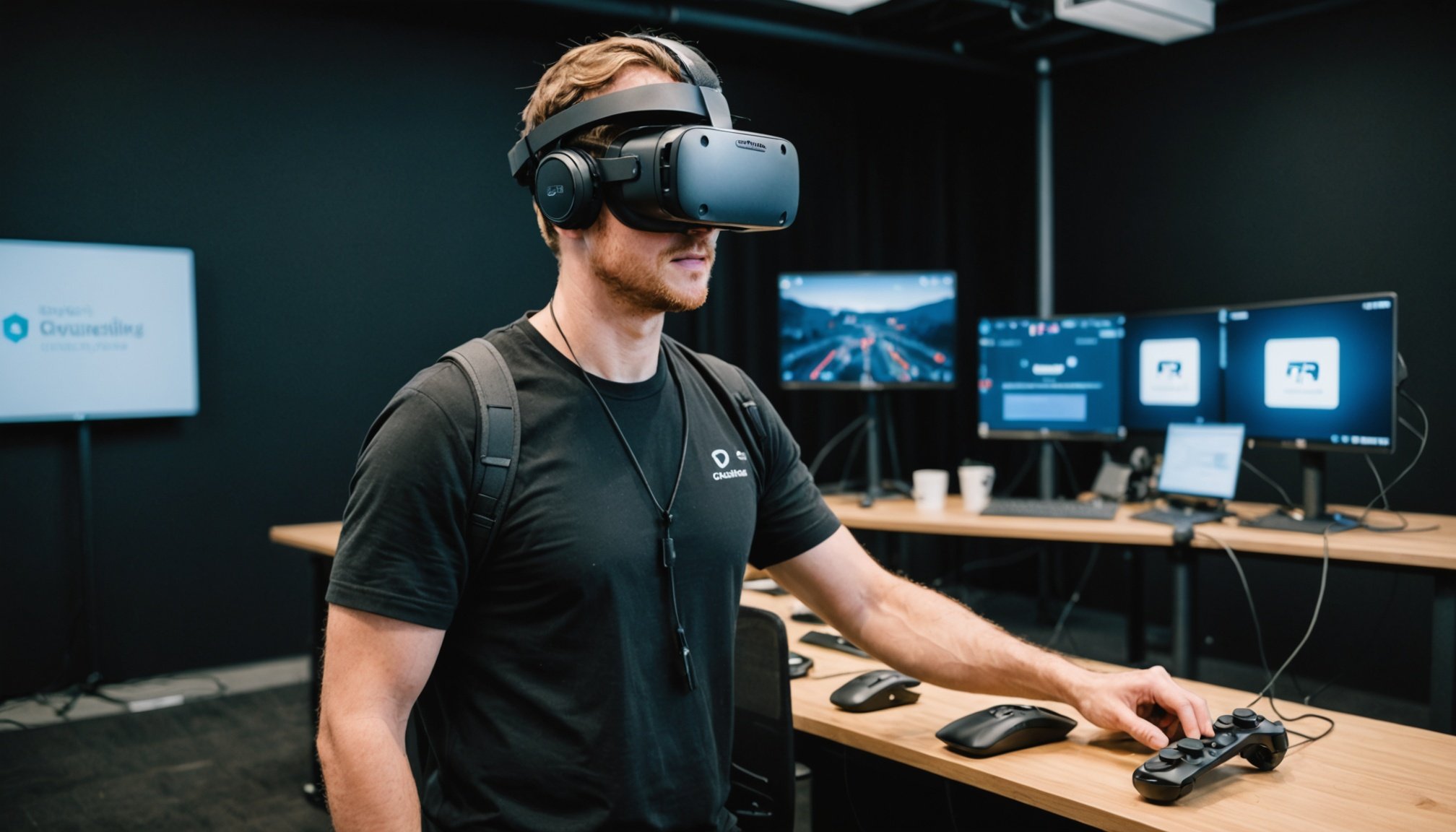Technical Challenges in Hybrid VR and AR Development
Navigating the technical obstacles in hybrid VR and AR development can be daunting. A primary hurdle is achieving hardware compatibility. Ensuring seamless performance across diverse devices often requires substantial time and resources. Devices differ significantly in specifications, necessitating extensive testing and optimization.
Integrating advanced graphics and processing technologies is another notable challenge. Developers must harness cutting-edge technologies while maintaining performance. This often involves balancing resource-intensive processes, such as rendering high-fidelity visuals with maintaining latency to ensure smooth user experiences.
Also to see : Shattering the limits of visual fidelity: how real-time ray tracing elevates space exploration gaming
A key aspect of these complexities lies in software integration problems. Building effective hybrid VR/AR solutions requires orchestrating numerous software components to work harmoniously. This process can be fraught as disparate systems must communicate, each potentially presenting unique technical obstacles.
Establishing cross-platform functionalities compounds these challenges. Developing VR/AR experiences that function consistently across various operating systems and devices is no small feat. Such development requires designing flexible architectures capable of accommodating different APIs and supporting libraries.
In parallel : Mastering real-time voice modulation: top techniques for fluid communication in multiplayer gaming
Overcoming these hybrid VR/AR complexities demands innovative solutions and a thorough understanding of existing and evolving technologies. These challenges reflect the intricate landscape that developers must navigate to deliver next-generation immersive experiences.
Design and User Experience Challenges
In the realm of gaming, creating immersive experiences that captivate users is paramount. Balancing intuitive user interfaces with complex functionality remains a significant challenge. Game developers must ensure that interfaces are streamlined enough to be user-friendly while maintaining the depth needed for advanced gameplay features.
One of the primary design obstacles is crafting environments that both engage the player and feel genuine. Gamers seek experiences that transport them to new worlds, requiring developers to seamlessly integrate storytelling and interactive elements. This balance can often dictate the success of a game, as overly complex systems may alienate users, while too simplistic an approach might fail to capture the audience’s imagination.
Furthermore, addressing accessibility considerations in hybrid environments is crucial. Developers aim to make their games enjoyable for a wider audience, including those with disabilities. This involves incorporating features like customizable controls, text-to-speech options, and variable difficulty levels. By considering a diverse player base, developers not only enhance gameplay but also promote inclusivity within the gaming community. Such meticulous attention to design and usability underscores the complexities of delivering a stellar user experience in today’s gaming landscape.
Content Creation and Asset Development
Navigating the world of content creation, especially in interactive 3D spaces, presents unique challenges. Crafting high-quality, immersive environments often encounters asset development hurdles. These include the complexity of designing detailed models and ensuring seamless functionality within a game engine.
To overcome these challenges, effective content creation strategies are vital. A methodical approach to resource management can make a significant impact. By prioritising tasks, allocating resources efficiently, and leveraging automation tools, development teams can streamline their processes. This ensures that even the most complex projects remain on track and within budget.
At the heart of successful content creation lies the importance of narrative design. An engaging narrative is crucial for immersive gameplay experiences. It acts as a framework that guides asset development, ensuring that every model, texture, and animation supports the storytelling goals.
Utilising smart strategies for time management, such as breaking down projects into manageable sprints, can improve productivity. Thus, while asset development may have its hurdles, strategic planning and narrative integration are keys to overcoming these challenges and enhancing player engagement.
Market and Audience Considerations
Understanding the target audience preferences in hybrid gaming is crucial for developers aiming to create engaging content. Insightful market analysis can illuminate these preferences, guiding content creation and feature integration. This involves using data analytics to assess gamer demographics, preferences, and behaviours, ensuring game development aligns with user expectations.
Strategies for gathering and analyzing user feedback effectively are equally important. Techniques such as surveys, focus groups, and social media monitoring enable developers to garner valuable insights. These methods help capture gamers’ opinions, allowing companies to refine games and address any emerging issues promptly. Data-driven adjustments can significantly enhance player satisfaction and retention.
Anticipating market trends and evolving user expectations demand a proactive approach. Staying informed about technological advancements and cultural shifts in gaming ensures that developers cater to an audience whose tastes may change rapidly. Regularly updating games with new features or modifying gameplay mechanics keeps the content fresh and appealing.
Incorporating these audience engagement strategies not only improves game quality but also fosters a loyal community. By aligning with evolving trends and prioritizing user feedback, developers can maintain a competitive edge in the fast-paced hybrid gaming market.
Emerging Technologies and Industry Trends
Within the dynamic realm of hybrid VR/AR, we are witnessing remarkable technological advancements. These emerging tech trends are continually reshaping user experiences and setting new standards in the market. A significant aspect of this evolution is the integration of enhanced sensory feedback systems, enriching AR/VR environments through haptic technologies and spatial audio.
In looking at the future horizons in VR/AR, one compelling trend is the development of cloud-based solutions. These platforms are poised to revolutionise how content is stored and accessed, facilitating more dynamic and interactive game development processes. This approach reduces hardware limitations, opening new possibilities for immersive storytelling and gameplay.
Insightful interviews with industry experts have highlighted a shift towards more accessible and inclusive VR/AR experiences. Professionals predict that ongoing innovations will also focus on adaptive technologies, ensuring broader audience engagement and expanding the market reach.
As these advancements continue, it is vital for developers and stakeholders to remain vigilant, adapting to and anticipating changes. These evolving industry trends not only promise to enhance gaming experiences but also pave the way for richer and more interconnected digital environments on a global scale.
Case Studies of Successful Hybrid VR and AR Games
Exploring successful hybrid VR and AR games offers valuable insights into the industry’s potential and growth. These case studies illuminate the development processes that have led to triumphs in this burgeoning field.
By examining the development processes of trailblazing games like “Pokémon Go,” one can see that engaging gameplay with real-world interactions is crucial. The game’s success lies in its ability to merge an augmented reality experience with the beloved Pokémon universe, drawing players outdoors and creating a community-driven engagement.
Another success story is that of VR game “Beat Saber,” which showcases the power of simplicity combined with a high-energy experience. Its straightforward gameplay, synched to music, underlines the joy that can be delivered through immersive VR environments.
Learning from failures is just as crucial as celebrating successes. Projects like “Google Glass” encountered challenges with user interface complexity and societal integration. These lessons drive home that seamless user experience and practical application are vital.
Developers should take key takeaways from these examples, such as prioritizing user experience and understanding community dynamics. These elements are fundamental in crafting games that not only succeed but also create sustainable engagement.
Best Practices and Solutions
Developing hybrid games presents unique challenges that require innovative strategies and solutions. Key development strategies focus on integrating various gaming elements seamlessly. One approach is leveraging modular design, which allows independent components that can be easily modified or replaced without impacting the entire system. This flexibility is crucial in addressing unforeseen challenges in hybrid game development.
To ensure a smooth development process, prioritising techniques for effective testing and iteration is essential. Regular playtesting with diverse user groups helps in gathering valuable insights and identifying pain points early. By embracing an agile approach, teams can iterate rapidly, refining gameplay mechanics based on real-time feedback. This iterative process enhances the game’s quality and ensures that it aligns with player expectations.
Collaboration tips are vital for multidisciplinary teams involved in hybrid projects. Encouraging open communication and adopting collaborative tools can significantly enhance team productivity. Scheduling regular cross-discipline meetings ensures that everyone is aligned with the project’s goals and helps in resolving conflicts promptly. Emphasising a shared vision and fostering a culture of mutual respect are key to overcoming hurdles in collaborative hybrid game development.
By following these best practices, developers can navigate the complexities of hybrid game development effectively and produce games that deliver engaging, seamless experiences to players.











